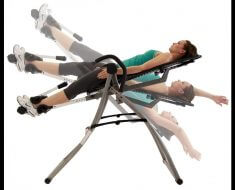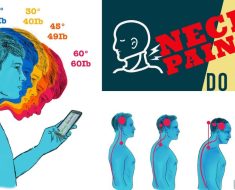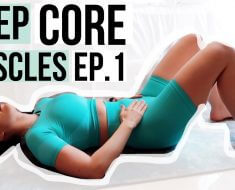Stretch Eliminates Back Pain

But when she drops lower, did you see how that opens up there now, what she’s doing she’s, not even actually at 90 degrees, yet down here, they’re now at that point, she’s actually rounded in here, which is bad for her disc bulge, so come on back up Again because then she goes into extension, which sort of winks the butt there and she comes up again so for this one, for her safety-wise and for anyone. Who has got a disc bulge and wants to prevent any back pain? As you can go below the point where you’re going to lose a neutral spine, so at that stretch eliminates back pain point there she can’t go that low. Now, for some people, they’ll be able to go lower than that they’ll be able to go right to 90 degrees because they’ve got heaps of range in the hip.
They’ve got really good core stability. Here they don’t lose any neutral spine, but for her, she needs to be very aware and look in the mirror about her position. So you see that neck. So if you come down again for me, she needs to go. Woo come back up and she needs to get used to where that position is okay because if she goes in lower she goes into flexion she’ll, then posterior, bulge, that disk, and then reinjure herself, so she’s got to work on that. The other thing she’s got to work on is she loves stretch eliminates back pain, being hyperextended here all right, so this position here needs to actually become a bit neutral. Now I don’t mean go into flexion, I mean she just needs to stay in neutral, so she’s got to really hold on the interior with her core there and when she squats she’s got to keep it on. She wants to just till she wants to tilt this pelvis. Like that to kind of squat, because she wants to behold her spine extension instead of going into flexion, but that goes really bad.
When she gets down to the bottom, so she’s got to learn. Can I hold neutral in the spine and bend at the hips, so the hips have to go down and back so try that for me neck there you go that’s better, and then she drops Laura Laura like she still has to watch her breakpoint. She keeps her neutral spine, just so much harder right, and then comes back up with a hip extension. So when she comes back up, she doesn’t have to then tuck a bum under it’s actually in neutral. So the trick is to start a neutral and go very slowly down. Extending the hips backward and down into that position that she maintains initial, don’t go below that breakpoint and wink the butt, and then, when she comes back up, he’s, got the angle to extend, and then she comes back neutral and that’s it hard to practice and she’s. Just doing the bodyweight of mine because it’s if you try and put heaps of weight on there, she’s going to one go into an old pattern, but she’s also just going to load the spine, which we don’t want.
Okay, so for her, it’s going to be really hard for her to try and try that again with a bar, it’s going to try it it’s going to be hard for her to do a back squat in that position because, if occur in the swinging, if she Tries to a back squat what happens? If you tend to extend through your spine up that so she’s going to find it quite hard to keep a neutral when she goes down, so you try that for me? Yes, just kind of find it see that, did you see that so she went straight into an extension that point there comes back up again. So I don’t really like this for knee pain, so you wouldn’t elevate someone’s heels. If you had patellofemoral pain, you wouldn’t do that, but for her what we can do as long as those feet are apart, she keeps her knees apart. We can elevate her heels to help her with her spinal position when she squats with the intention that you’re going to take these plates away at some point. Okay, especially if she has knee pain, we’re not going to use them, but now try that for me and you’ll find that she is able to maintain a better form, there’s that but Winkie. So again, let’s try that again. This is where hands-on helps a little bit. So neutral she sits down and back hold, hold woo and then come back up and I’m just guiding it with my hands to try and keep her neutral making her be into the hips.
The most try again for me she didn’t do that by yourself and she’s a little bit too upright. Do you see that so we’ve got to try and get the angles of her upper body the same as shin? Okay? So try that again for me forward North upper body, that’s a bit better, we’re getting there woo and then come back up and bummer yeah okay. So this is how we learn to try and get a better and better squat. What I would do with her, though, to make things even better, as you were, doing a front squat so front squat, the harbor, the bar, so we better to scrub her. You start off with a kettlebell. There you go now. That’S ten kilos with her does problem. Tenth year, who does the problem, ten kilos is okay. I probably wouldn’t go to twenty at this stage. Just straighten your feet up for me in here. That’S it alright! So from here, because the way from the front she can then concentrate on what’s going on with their spine.
Here so try that stretch eliminates back pain again, so mutual spine sits back, hold push back up, I forward so make sure you don’t tuck the bomb under that’s bomb forward. So you extend the hip, go again, fine good and come back up and again she’s, maintaining still a quite an upright spine. We’ll get that angle forward a little bit better as we go, but that’s looking really good now tips for her is to so she can see what she’s doing she needs to then go side onto the mirror and see her own spine and make sure that’s all Correct but that’s great okay, okay, we’ve practiced a little bit so show us again when you no need to do and she’s using now the mirror side-on and what she’s getting as way better technique now, which he watches it and now she’s got that perfect angle Of back and shin together, she’s got a knee. Wide okay, she’s got feet. Parallel knees wide.
She doesn’t want to be like this. Okay go again and she’s worked out how to not but wink and keep a neutral spine not be too upright. Keep it forward. A bit, but also she’s, worked out how to not extend here. She’S worked out how to extend at the hips and keep the spine in neutral, so she’s before she was sort of sitting. Her bum outwards now she’s holding here and now. She’s worked out that you can bend here and being here, squat down to fall in and those the two points of the pivot, and then this will naturally come down and you’ve got that perfect. I live in there and yes, we’re up on a plate as you carp again and when she’s looking left, it’s really hard to hold weight. So you practice with a mirror with no weight, so you do not sort of wrecking your neck with a weight, and then, as you get the form right, then you can add the weight as you get a better score. stretch eliminates back pain gives stability, better awareness of hip pinch here. Take the plates away:







